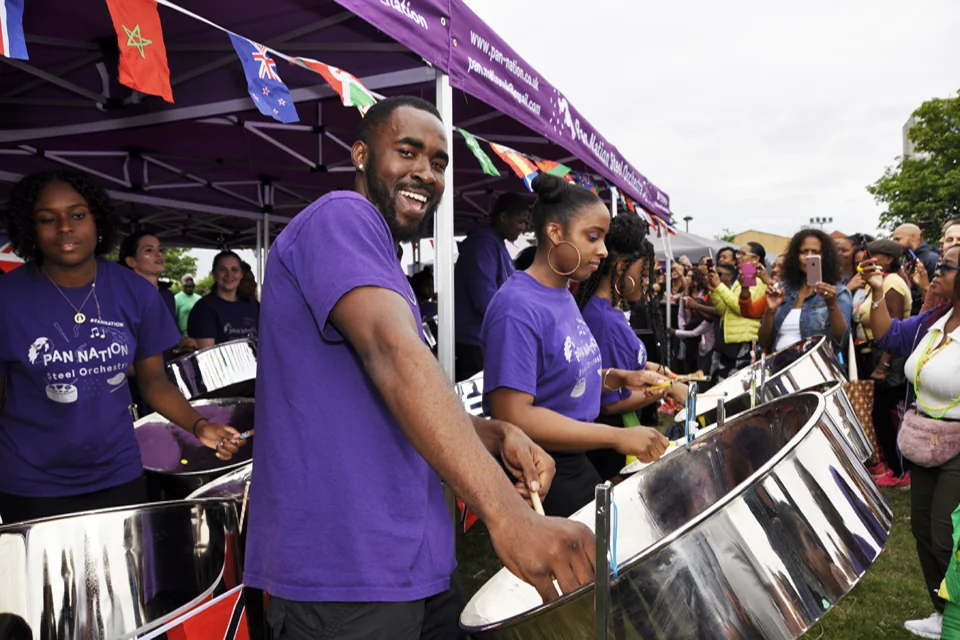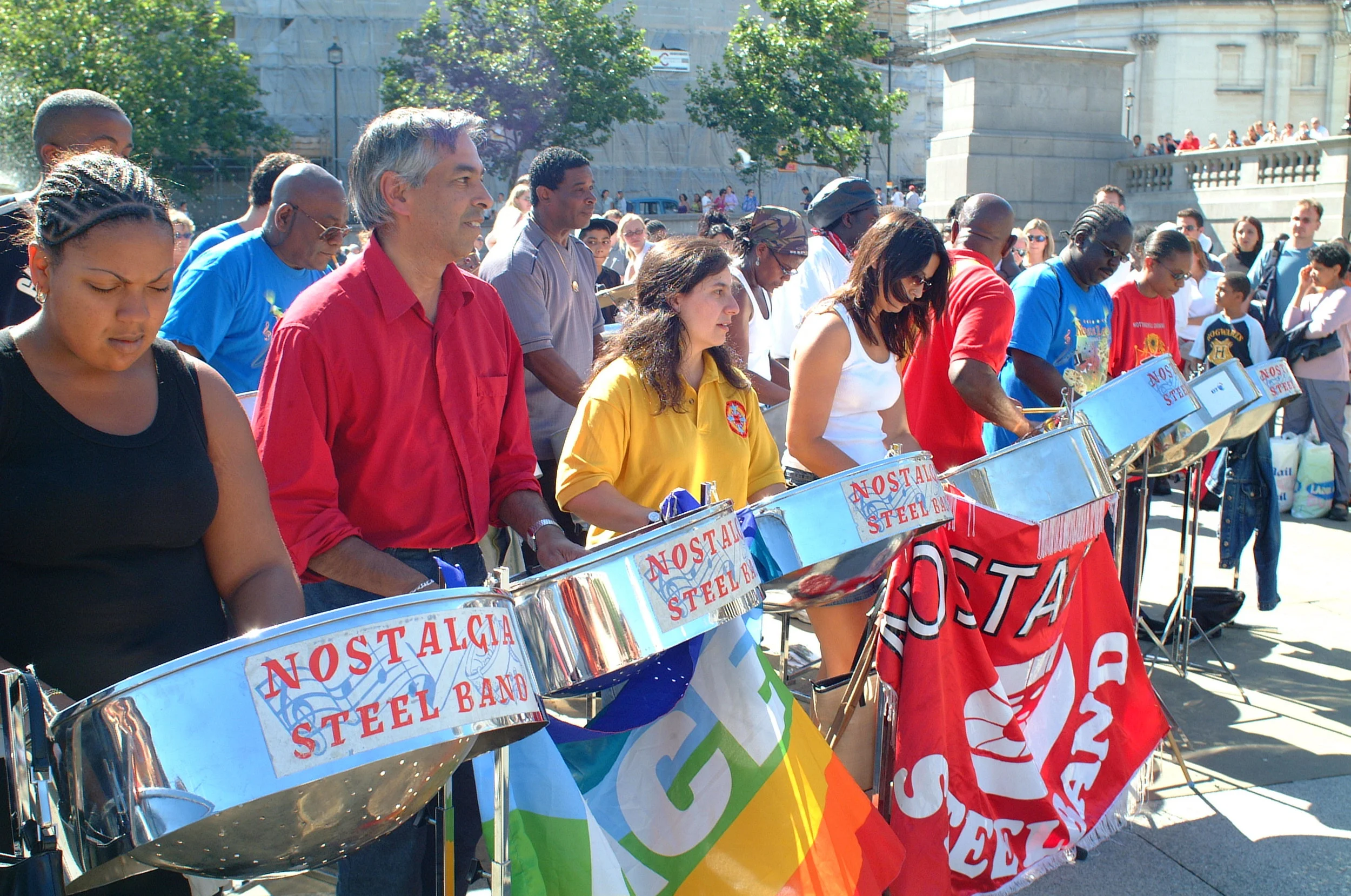The History of Steelpan in Notting Hill Carnival and Steelband Panorama.
The Steel Pan instrument made its first appearance on British TV in 1950, thanks to Trinidadian creative Boscoe Holder and his Caribbean Dancers. The first steel drums performed on his own television show, Bal Creole, broadcast on BBC Television on 30th June 1950.
With the exposure of the instrument so widely broadcast the previous year, The Trinidad All Steel Percussion Orchestra (TASPO) were invited to play in the summer of 1951 on the Southbank in London as part of the ‘Festival of Britain’. This was the first time the British public came into direct contact with the instrument. It was hard to comprehend how a 55 gallon oil drum could make musical sound let alone be used to play melodies of songs and the public literally looked under the steel pans to check the sound was actually coming from the instrument.
Many of the TASPO players decided to remain in the UK to pursue their love of music and spread knowledge about the steel pan, which at the time was struggling to be accepted as an instrument in the world of music due to its creation less than a decade before and the lack of proof that the instrument could accurately control its pitch, tone and cover the chromatic scale.
Russell Henderson arrived in the UK in 1951, an established recorded pianist from Trinidad. He was exposed to the early birth of the Steel pan and when he arrived in London he teamed up with drummer and accomplished steel pannist, Sterling Betancourt, one of the original TASPO players to remain in the UK after the Festival Of Britain. They enlisted the help of Mervyn Constantine, Max Cherrie and his brother Ralph Cherrie, at different stages of the band performing as a trio, they formed ‘The Russell Henderson Calypso Band’. They were quickly identified as brilliant entertainers, having regular bookings for clubs and small venues, which eventually led to them being the first steel band to play for royalty at a garden party in Buckingham Palace. The band amazed audiences wherever they played the steel pan.
In April 1964, Russell’s band was invited by Rhaune Laslett to play steel drums at her annual children’s event on Tavistock Road, W11. Russell’s steel band were met with rapturous applause and an encore was requested, it was at this point Russell decided to really give his audience a taste of Trinidad and as all the Steel pans were fastened around the necks of each player it allowed them to be mobile whilst they played. So they started to walk, in time with the beat. Everyone involved with the event were in a conga line behind the steel band who led them down the streets between Tavistock Crescent and Portobello Road. The general public who heard the music, saw the small parade, joined in and there were even people coming out of their houses to join in the parade/impromptu street party.
This was undoubtedly the spark that gave Rhaune Laslett the idea to apply to the local council for permission to have an outdoor event, as she saw the impact the steel pan had in uniting the local community and hoped she could replicate this by encouraging the small communities of a very multi cultural West London at the time to take part by infecting ‘them with a desire to participate’, stating ‘this can only have good results’. She managed to achieve this goal and ‘The Notting Hill Fayre and Pageant’ was held over the course of a week from the 18th September 1966,
Gary Younge (Guardian) has written, Laslett "spoke to the local police about organising a carnival....with more of an English fete in mind, she invited the various ethnic groups of what was then the poor area of Notting Hill - Ukrainians, Spanish, Portuguese, Irish, Caribbean’s and Africans - to contribute to a week-long event that would culminate with an August bank holiday parade....she borrowed costumes from Madame Tussaud's; a local hairdresser did the hair and make-up for nothing; the gas board and fire brigade had floats; and stallholders in Portobello market donated horses and carts. Around 1,000 people turned up, according to police figures."
Involved with its conception and present throughout Notting Hill Carnivals history, steel bands are an integral part of Notting Hill Carnivals tradition. Bringing the unique sound and energy of the Caribbean to the streets of London. It takes year round, and even lifelong dedication to master the steel pan.
The annual steel pan ‘Panorama’ event and Notting Hill Carnival are where the best of the best pan players and steel pan bands from all over the United Kingdom really showcase their skills.
Panorama
The only way to really experience a Panorama is to attend but for those who have never had the pleasure then here’s what to expect:
Listening to live music is always a wonderful treat for anyone senses, the sound, atmosphere, environment, vibe and spiritual energy of the instrument, or the person who plays it appeals to our creative admiration.
Making your way towards Panorama is a build up all by itself. Like a football match, you will spot a lot of supporters of the bands going towards the direction of the competition walking along the road or pavement in small groups having leisurely conversations, children of all ages accompanied by their parents, aunties, uncles, cousins, friends, there is a real sense of community spirit.
As you near the road the competition is held on, you will undoubtedly hear a steel band orchestra in the distance practicing before going on stage. Its an open air practice and you quickly realise that you can join the crowd surrounding the band, and be within a few feet of the players as they are not just the bands supporters but also the general public who have attended. You can listen to all the bands practice before they take to the stage for their final performance for free. This is a great way to listen to the music more than once, and also lends opportunity to enjoy a few beers and a chicken roti, lamb pattie or curry goat and rice as you are surrounded by the smells of the Caribbean, which become irresistible to the senses.
Listening to a full 70 plus individuals, playing together as one steel pan orchestra can be overwhelming for the senses when first experienced. The sound of a steel pan is very unique, the sound of a steel pan orchestra is unforgettable. You can physically feel the energy from the orchestra working its way into your feet, when you suddenly realise your moving them to steady melodic rhythm and your body quickly follows.
Accompanied with the visual of a steel pan orchestra playing a piece of music live adds to the captivation and your unable to move and think, so you just listen and immerse yourself in the atmosphere of others around you who are doing the same. There is a real sense of community feeling as the musical performances spark conversations within the crowd and the excitement of identifying a winner keeps you on edge which further builds your bond to the event, the bands and its players.
Credit: Kevin Joseph






